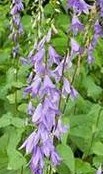
Ladybells are herbaceous perennials in the bellflower family, Campanulaceae, that also includes balloon flower and lobelia. The genus has about 50 species most of which are native to Asia, some from central Europe. The plants have fleshy roots, numerous branched, slender stems, simple, alternate leaves, and fragrant, nodding, bell-shaped, blue flowers. They like average, medium moist, well-dained soil in full sun to partial shade and look lovely grouped in a border or woodland garden. Ladybells are more heat tolerant than other members of the Companulaceae family and a good choice for southern climates. The genus name, Adenophora, comes from Greek words aden meaning gland and phoro meaning bear, referring to the sticky nectary around the base of the style.
Two species and a hybrid cultivar are available.
Common ladybell (A. confusa)
Native to China, common ladybell is the most popular of the genus with its deep blue. 3/4″ long flowers that appear in loose panicles in the late spring and last up to three weeks. The plant is 2-2 ½’ tall and has kidney shaped basal leaves and narrowly ovate to elliptic, stem leaves that are 1.5-3″ long and finely toothed.
Height: 2-2.5′
Flower Color: Deep blue
Hardiness: Zones 3-8
Lilyleaf ladybell (A. lilfolia)
Native to Europe, lilyleaf ladybell is 2-3′ tall and has light blue to white bell-shaped fowers and wedge-shaped leaves that are 3″ long and deeply toothed. It is more heat tolerant than A. confusa and a better choice for southern gardens.
Height: 2-3′
Flower Color: Light blue to white
Hardiness: Zones 3-8
‘Amethyst’
This hybrid cultivar is of unknown parentage. It grows up to 3′ tall and has toothed leaves up to 3″ long and amethyst blue flowers. It is the least heat tolerant of the three species cited here.
Height: Up to 3′
Flower Color: Amethyst blue
Hardiness: Zones 3-7